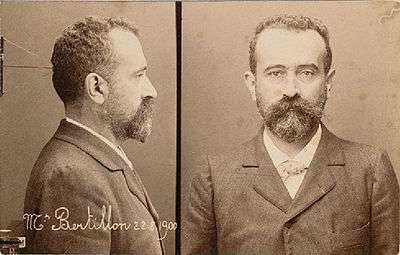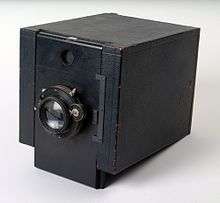Mug shot

A mug shot or mugshot (an informal term for police photograph, or booking photograph), is a photographic portrait typically taken after a person is arrested.[1][2] The original purpose of the mug shot was to allow law enforcement to have a photographic record of an arrested individual to allow for identification by victims and investigators. However, in the United States entrepreneurs have recently begun to exploit the mug shot for commercial gains via the Mug shot publishing industry.
Photographing of criminals began in the 1840s only a few years after the invention of photography, but it was not until 1888 that French police officer Alphonse Bertillon standardized the process.
Etymology
"Mug" is an English slang term for "face", dating from the 18th century.[3] Mug shot can more loosely mean any small picture of a face used for any reason.[4]
Description
A typical mug shot is two-part, with one side-view photo, and one front-view. The background is usually stark and simple, to avoid distraction from the facial image (as distinguished from a casual snapshot in a more naturalistic setting). Mug shots may be compiled into a mug book in order to determine the identity of a criminal. In high-profile cases, mug shots may also be published in the mass media.
History

The earliest photos of prisoners taken for use by law enforcement may have been taken in Belgium in 1843 and 1844.[5] In the United Kingdom, police in Liverpool[6] and Birmingham[7] were photographing criminals by 1848. By 1857, the New York City police department had a gallery where daguerreotypes of criminals were displayed.[5]
The Pinkerton National Detective Agency began using these on wanted posters in the United States. By the 1870s the agency had amassed the largest collection of mug shots in the U.S.[8]
The paired arrangement may have been inspired by the 1865 prison portraits taken by Alexander Gardner of accused conspirators in the Lincoln assassination trial, though Gardner's photographs were full-body portraits with only the heads turned for the profile shots.
After the defeat of the Paris Commune in 1871, the Prefecture of Police of Paris hired a photographer, Eugène Appert, to take portraits of convicted prisoners. In 1888, Alphonse Bertillon invented the modern mug shot featuring full face and profile views, standardizing the lighting and angles. This system was soon adopted throughout Europe, and in the United States and Russia.[9]
The arrested person is sometimes required to hold a placard with name, date of birth, booking ID, weight, and other relevant information on it. With digital photography, the digital photograph is linked to a database record concerning the arrest.
Use in wanted posters

Mug shots have often been incorporated into wanted posters, including those for the FBI Ten Most Wanted Fugitives list.
Use in online mug shot publishing
In the US in the early 21st century an online industry developed around the publication and removal of mug shots from internet websites.
Prejudicial nature
The US legal system has long held that mug shots can have a negative effect on juries. The United States Court of Appeals for the District of Columbia Circuit held "The double-shot picture, with front and profile shots alongside each other, is so familiar, from 'wanted' posters in the post office, motion pictures and television, that the inference that the person involved has a criminal record, or has at least been in trouble with the police, is natural, perhaps automatic."[10]
The Handbook of Massachusetts Evidence says "Because of the risk of prejudice to the defendant inherent in the admission of photographs of the 'mug shot' variety, judges and prosecutors are required to 'use reasonable means to avoid calling the jury's attention to the source of such photographs used to identify the defendant.' " (p. 617) Elsewhere it cites a ruling in Commonwealth v. Martin that "admission of a defendant's mug shot is 'laden for characterizing the defendant as a careerist in crime'".
Other states have similar rules.[11]
Use with non-criminals
Despite their association with accused criminals, mug shots are also taken often in a non-criminal context. They are usually required from applicants for a driver's license, identification card, passport, or security clearance. Photos similar to mug shots are routinely taken for yearbooks, class picture books, or "face books" in an educational or social group setting. The format is simply a way of capturing facial appearances in a somewhat standard setting, to allow later identification or recognition.
However, the compilation of facial databases by large organizations, such as corporations or governments, may sometimes be perceived/seen as sinister or oppressive. Totalitarian regimes, such as Communist East Germany or the Pol Pot regime in Cambodia, have devoted much effort to compiling comprehensive mug shot databases of their populations, including many innocent people who were never previously involved with the criminal justice system. Civil libertarians have expressed great concern about possible misuse of large facial recognition systems and databases, as enabling an oppressive surveillance state.
See also
- Bruzz video: the world's oldest mug shots date from 1843
- Mug shot publishing industry
- Rogues gallery
References
- ↑ "mugshot". Dictionary.cambridge.org. 2013-10-29. Retrieved 2013-11-23.
- ↑ Michael H. Graham (2003). Handbook of Illinois Evidence. Aspen Publishers. p. 147. ISBN 978-0-7355-4499-4.
- ↑ "Online Etymology Dictionary". Etymonline.com. Retrieved 2013-11-23.
- ↑ "Merriam-Webster Online Dictionary". Merriam-webster.com. 2012-08-31. Retrieved 2013-11-23.
- 1 2 Kennedy, Randy (September 15, 2006). "Grifters and Goons, Framed (and Matted)". New York Times. Retrieved February 15, 2014.
- ↑ Norfolk, Lawrence (September 17, 2006). "A history of the twentieth century in mugshots". The Telegraph. London. Retrieved February 15, 2014.
- ↑ Papi, Giacomo (2006). Under Arrest: A History of the Twentieth Century in Mugshots. London: Granta Books. pp. 144, 163, 165. ISBN 9781862078925.
- ↑ Julie K. Petersen (2007). Understanding Surveillance Technologies: Spy Devices, Privacy, History, & Applications. Auerbach Publications. p. 26. ISBN 978-0-8493-8319-9.
- ↑ Pellicer, Raymond (2010). Mug Shots: An Archive of the Famous, Infamous and Most Wanted. New York: Harry N. Abrams, Inc. ISBN 9780810996120.
- ↑ Barnes v. United States, 124 U.S.App.D.C. 318, 365 F.2d 509, 510--11 (1966)
- ↑ "Where admitted, to the extent possible, the mug shots should be taped over or cut to delete all reference to booking information and be undated. The photographs should not be referred to as either "mug shots" or "booking photographs."" Handbook of Illinois Evidence, Michael H. Graham, §401.8 (citations omitted)
| Look up mug shot in Wiktionary, the free dictionary. |
| Wikimedia Commons has media related to Mug shots. |